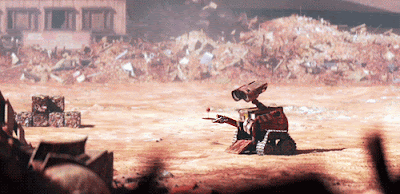Spare-partacus
or
"All creatures tread across the rubble of ruined civilizations. The trick is to keep moving. No animal ever goes about dispensing shallow compassion." Rita Mae Brown
After what I felt was a genre and craft high-point with the 2006 Ratatouille comes the last of the original Pixar concepts (devised on a napkin at a lunch just before the completion of Toy Story between John Lasseter, Peter Doctor, Andrew Stanton and Joe Ranft, which included story ideas for A Bug's Life, Monsters, Inc., Finding Nemo and this film) directed by Stanton, whose Finding Nemo was, itself, the craft high-point for its time. By now, the work of the Pixar pixilators is so assured that, really, all they have to do is show that they can do variations of tone, and they do that with Wall•E, the little trash-compactor that could.
This charming film starts out on a barren, blasted planet Earth, devoid of all life, save for one cockroach and a mobile trash-compactor, whose sole preoccupation for the last 700 years (when humans vacated the planet on elephantine space-cruise-liners) is to pick up the trash, scrunch it into cubes, then make big piles of said cubes, like rusting ancient Aztec ruins, dwarfing their man-made counter-parts, city skyscrapers. Wall•E is apparently the only Waste Allocation Load Lifter (Earth-Class) left, stripping others of his type for parts, and he works his dutiful existence scrunching by day, and collecting odd bits of human jetsam, and perpetually watching an old copy of Hello Dolly!, and yearning for companionship, before backing-up onto his rotating work-bench, and rocking himself to sleep-mode.
It is a melancholy vision of Hell, not unlike the empty, echoing, New York of I Am Legend, but with pelting dust-storms and no signs of life, not even encroaching vegetation. One watches a fast scene of Wall•E giving chase in a rubble-strewn long-shot and can't help marveling how far the artistry has come from Toy Story. Not only do things look photo-realistic, but there's also a fine atmospheric haze over the scene, giving it life and depth.
The film is also rich in satire, with the future Earth a global economy dominated by the BnL (Buy n' Large) Stores, which have control of everything. The human populations are adrift in ocean-liner-type space barges, that might be called "The Lard Boat" as the human passengers have become infantile all-consuming non-producing blobs in floating lounge-chairs while television screens perpetually float six inches in front of their faces.
It is funny, touching, and definitely dark in its view of the future, and Wall•E finds himself the cog in the wheel for a robot and human revolution against mechanical Masters eager to maintain the Status Quo.It is a melancholy vision of Hell, not unlike the empty, echoing, New York of I Am Legend, but with pelting dust-storms and no signs of life, not even encroaching vegetation. One watches a fast scene of Wall•E giving chase in a rubble-strewn long-shot and can't help marveling how far the artistry has come from Toy Story. Not only do things look photo-realistic, but there's also a fine atmospheric haze over the scene, giving it life and depth.
The film is also rich in satire, with the future Earth a global economy dominated by the BnL (Buy n' Large) Stores, which have control of everything. The human populations are adrift in ocean-liner-type space barges, that might be called "The Lard Boat" as the human passengers have become infantile all-consuming non-producing blobs in floating lounge-chairs while television screens perpetually float six inches in front of their faces.
Two quibbles, nothing alarming enough to distract from any enjoyment of the film, but still things to ponder: Ben Burtt provides the voice of Wall•E as well as the sounds of all the other things in the film as sound designer and mixer, and he does the same thing here that he's done with the recent re-mixed "Star Wars" films, which is prioritize mixing the sound effects over the music, thereby drowning out Thomas Newman's quirky, enjoyable pastiche score--let him sound-design and mix his work, sure, but keep out of the final mix; and, one wishes that Pixar had the scrap to end the film on a minor chord, rather than it's crowd-and-kid-pleasing major one. If they had left the fate of one of the characters ambiguous, Pixar would have had their own version of Chaplin's bittersweet ending for City Lights.
These are small quibbles, and certainly don't detract from the mammoth effort and resulting entertainment that keeps coming out of "Pixar," which is becoming the only real sure-bet in Hollywood.









No comments:
Post a Comment